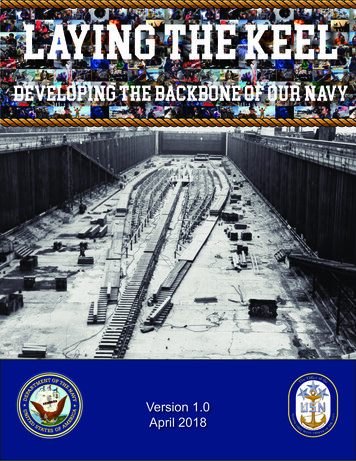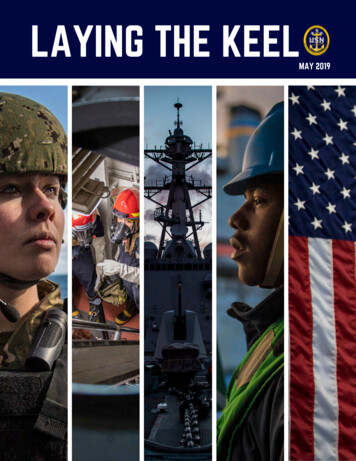
Transcription
Laying the KeelDeveloping the backbone of our navyVersion 1.0April 2018
IntroductionAs our Navy grows and evolves to protect America's interests in a fast paced, more complex andincreasingly competitive environment, more will be expected and demanded from its Enlisted Leadersat all levels.Today, we are the strongest Navy in the world by any measure – we have the most ships, the bestequipment, and more importantly the finest Sailors. Petty Officers have been demonstratingtechnical competence and devotion to duty in our Navy since 1775. Just as our capital assets,procedures, policies and technology have evolved over the course of our history, so has the processto develop effective leadership qualities that address the challenges our Sailors face. Our Sailorstoday are recognized worldwide in their distinct ability to overcome adversity, courageously facechallenges and accomplish our Navy's mission as the world's most well trained and combat readyforce.The Navy the Nation Needs will require our Enlisted Leaders to be continuously flexible, moreinnovative and confident in achieving operational excellence in tougher and more challengingenvironments. As our Sailors operate on all domains, from the sea floor to space, their daily duties,mission and challenges may be unique, but must all be united in their understanding of expectationsand in their obligation to develop all of their skills in every realm from technical proficiency toleadership. The character development and adherence to our Ethos that has been habitual sinceaccession into the Navy must be reinforced periodically throughout a Sailors career by applyingchallenge, adversity, training, education, alignment and accountability through both experience and adeliberative leadership development process. The character that has been forged is hardened and aleader is developed who is aligned with our true North, who is further prepared to continue the legacyestablished by those that served our Navy throughout its storied history. This will ensure the U.S.Navy remains the best in the world with the brightest and most capable people defending the nation.Our Navy cannot build the framework for leadership development without starting with "Laying theKeel." As our future Enlisted Leaders proceed from the stern to the bow over the course of theircareers, marking each milestone and advancement by adding the frames to their Keel, they arebuilding the Backbone of our future Navy that is both enduring and deeply connected to the Heritageof those that went before them.LAYING THE KEEL – Developing the Backbone of Our Navy:Sets the foundation for a series of formal courses throughout the career continuum. Coursesare short duration, high impact, adult learning experiences, with focus on: Character,Ethics, Leadership, the Profession of Arms, Self-Awareness, and Decision Making, facilitatedby trained and certified Senior Enlisted Leaders.CPO 365 Phase I evolves to SAILOR 360: Continue the Conversation, as a command ownedand managed program to continue the development beyond formal course work at thecommand level. It’s a broad, flexible approach designed to be all-paygrade inclusive.Formalizes and updates the CPO Creed, and aligns the expectations of every CPO to theCreed. Additionally, educates, develops and aligns CPOs to the ideals in the Creed during theprocess known as CPO Initiation.1
The Course Of Enlisted Leader DevelopmentDeveloping Enlisted Leaders is an evolving process. 125 years ago, the Navytook a major step by creating Chief Petty Officers to provide enlistedleadership and bridge the gap between officers and enlisted. Since,Enlisted Leader Development has been on a steady course of forging better,more competent and capable enlisted leaders with each generation – givingthe U.S. Navy an enduring competitive advantage over its adversaries. Thejourney continues as the Navy the Nation needs will demand more from itsEnlisted Leaders as it operates in a more complex and fast-pacedenvironment.1985-1988MCPON Plackett emphasizesprofessional education to remoldsenior enlisted structure. CPOIndoctrination is introduced.1973MCPON Whittet announcesestablishment of CPOselection board.1981The Senior EnlistedAcademy opens.1967Establishment of theOffice of the MasterChief Petty Officer ofthe Navy.January 8, 1885Navy classes enlistedpersonnel as first, second,or third class petty officers,and as Seaman first,second, or third class fornon-petty officers.1940sSailors must complete atraining course andexaminations for new rate.1970sPersonnel AdvancementRequirement (PARS) first mentioned.Sailors must demonstrate skills andabilities to be eligible for promotion.1958Public Law 85-422establishes E-8 and E-9classifications.April 1, 1893Establishment ofCPO classification.E-7 to E-9E-6 and below1950sSailors must complete“Performance tests andpractical factors as requiredby locally preparedcheckoffs” as one factor forenlisted advancement.1971CNO Advisory Board to theCNO begins seniorenlisted leadership structure.1990sNavy Leadership ManagementProgram (NAVLEAD) coursestrain Sailors to apply specificleadership skills in variousworkplace situations.
2011CPO 365 is introduced.1994Navy promulgates a newleadership developmentcontinuum designed to provideformal, consistent andprogressive training to all handsat key points in their careers.2007Petty Officer Second ClassLeadership Course (PO2SLC)launches.2001Naval War College launchesEnlisted Primary ProfessionalMilitaryEducation (PPME) course.2001CMC conference held to introduceCPO 21: Building the CPO & theCPO Mess of the 21st Century.2006CPO Leadership Course (CPOLC)developed to replaceCPO Indoctrination.2008Petty Officer First Class Selectee LeadershipCourse (PO1SLC) launches to provide“just-in-time” leadership training for the Navy’snewest first class petty officers.2006Petty Officer Indoctrinationwith Petty Officer SelecteeLeadership Course (POSLC)launches, for newlyselected E-4s.April 24, 2018Laying the Keel is released.SAILOR 360: Continue the Conversationand CPO Initiation are introduced.
Foundational TrainingAs the first step in Enlisted Leader Development after Recruit Training Command, the formal coursesproduced by the Navy's Leadership and Ethics Center are the foundation upon which all future leaderdevelopment occurs.Underscoring the imperative of a proper foundation, more than a year of intense study, curriculumdevelopment and fleet input were used to create and deliver the pilot courses in the newFoundational Training series. These courses replace existing Selectee Leadership Courses and areof similar length; but the similarities stop there.Several years ago Enlisted Professional Development courses migrated from brick and mortarschoolhouses to individual commands. Although some efficiency was realized in this move, therewere also unintentional effects as some commands and locations simply don't have the requisiteresources to deliver our Foundational Leader Development courses with the quality our Sailorsrequire for a solid foundation. Additionally, this training was traditionally triggered by advancementand targeted to specific paygrades.Foundational Training courses are intensely interactive and are facilitated by a cadre of instructorstrained and certified by the Navy Leadership and Ethics Center. These courses focus on Character,Ethics, Self-Awareness, Decision Making and Leadership, and are designed to be delivered off-sitein a location close to the waterfront or flight line. This hybrid delivery model ensures quality coursedelivery, flexibility and efficiency of these new short duration, high-impact advanced learningexperiences. These courses occur at appropriate regular intervals throughout a Sailor's career andare a deliberate, vigorous investment in an Enlisted Leader's development.Foundational Training CoursesFocus on Character, Ethics, Self-Awareness, Decision Making and Leadership.Occur at appropriate regular intervals throughout a Sailor's career.Delivered off-site in a location close to the waterfront or flight line.Are short duration, high-impact advanced learning experiences.This formal foundational training is the critical first step in "Laying the Keel" and starts the growthengine upon which Enlisted Leaders and their command will "Continue the Conversation".NMT/NP&PNavy Military Training4FLDCFoundational LeaderDevelopment Course (E3-E4)ILDCIntermediate LeaderDev Course (E5)ALDCAdvanced LeaderDevelopmentCourse (E6)CPO LDCChief Petty OfficerLeader Dev Course(E7)
The Sailor's CreedI am a United States Sailor.I will support and defend the Constitution of the United States of America and I will obey the orders ofthose appointed over me.I represent the fighting spirit of the Navy and those who have gone before me to defend freedom anddemocracy around the world.I proudly serve my country's Navy combat team with Honor, Courage and Commitment.I am committed to excellence and the fair treatment of all.SAILOR 360AchieveTheoreticalLimits ofPerformanceSelf-guidedLearningDevelop Sailorsthrough unit leveldiscussions;CNO’s/MCPON’sreading; smallRecommendedgroup seminars;self-guided andReading ListcommandsupportedProfessional Media,learning. ThisBlogs and Writingcombinedapproach aims toCollege Coursesinspire Sailors toperform at or nearLocal Professional their theoreticalGroupslimits.Foundational TrainingSEASenior EnlistedAcademyCMC/COBCommand SeniorEnlisted LeaderELSExecutive LeadershipSymposiumSTSNSLSNavy Senior Leader Strategic ThinkingSeminarSymposium5
SAILOR 360: Continue the ConversationAs we strengthen and broaden our Foundational Training curriculum, we must also look within ourcommands to compliment learning achieved in the formal classroom. Enlisted Leaders at all levelsequipped with Foundational Training are the subject matter experts each command must leverage tocreate a growth culture through the expert use of challenge, adversity, feedback and mentoring.SAILOR 360 is an umbrella term for innovative, creative, command-developed leadership programsmodeled after previous programs such as CPO 365 Phase 1 and scenario-based studies like Chief’sMess Training. Because SAILOR 360 is command-developed, leaders have the flexibility to tailorexisting source material to best fit their observed needs. Executed smartly and professionally, theseprograms can scale up across several peer groups or down into small-group discussions. This typeof command-led, command-developed and command-tailored character development builds uponFoundational Training and is vital to reaching our theoretical limits of performance.The leader development process is depicted in the model below. When these elements are notapplied frequently at regular intervals, a leader’s growth is stalled. Leader development begins withalignment, culminates with feedback and begins again with alignment. Applying the elements of this360-degree approach correctly ensures exponential ducationSE Skills Formal / Informal Blended / Self-Study Formal / Informal Blended / Self-Study Coach, Mentor, Teach,FeedbackTrain, CounselingSelfFeedback AwarenessTrainingEducationFeedbackiative Debriefs AdvocacySelf Awareness Know Thyself / Blind SpotsSelf SelfAwarenessRegulationE Standards / Traditions Routines Positive BehaviorAlignmentOpportunity Challenge / Adversity ExperimentationNEHabitsWss Ethos/Vision Profession of Arms Service / Sacrifice Our True NorthyNWhneAlignmentgritAccountability
WaypointsThe conversation occurs at all levels in the organization as determined by command leadership.This is an all hands on deck effort. Leveraging the compass centered on self-awareness willassist in developing focused outcomes. Instituting assement feedback mechanics will help drive acontinuous learning environment.Training activities and conversations should be relevant to each paygrade and/or the assignedduties of the Sailors involved.SAILOR 360 should also stress continued technical competency development appropriate to eachSailor, team and unit.Command leaders must take ownership of SAILOR 360 in their organization, and be singularlyaccountable for the safe, highly-professional and successful execution of training.Specific requirements, objectives, topics and training methods vary to fit each command.Continue incorporating Brilliant on the Basics.Leaders must approach each conversation and activity with the mindset of becoming a betteradvocate for their Sailors. This active step is important in leader development, requiring theleader to be proactive in providing their Sailors with professional opportunities.Also, include a variety of physical training activities, conducted per OPNAVINST 6110.1J. Medicalpersonnel, and certified fitness leaders, will be present at all PT activities.7
CPO InitiationDesired Outcome: A visible, confidently humble Chief Petty Officer relentlessly dedicated to thecontinuous improvement of themselves and their teams. Drives excellence in leading our Navy teamforward across the operational and warfighting competencies.This statement describes a Chief Petty Officer from the moment the results are released andcontinues through the rest of his or her life. As Sailors who champion the core values of Honor,Courage and Commitment, CPOs set an extremely high bar as leaders in the core attributes ofintegrity, accountability, initiative and toughness.Initiation is a professional education and training environment that starts when the announcementmessage is released and concludes with the CPO Pinning Ceremony.WaypointsEffectively train, integrate and accept Chief Selects into the CPO Mess. Similar to new shipsystems being tried and tested to their limits, ensuring the vessel is ready to join the fleet,acceptance gives the entire crew confidence in the ship's ability to perform.Instill the unique values, beliefs, and expectations required to contribute effectively andsucceed within the CPO Mess and to lead our Navy Team forward.Challenge the team/individual as leaders of integrity, accountability, initiative and toughness;evaluate performance, and provide candid feedback.Cultivate a culture of humility, trust, and loyalty to increase the speed of trust across our Navy.8
Teaching to the CreedThe CPO Creed is read each year at every CPO Pinning Ceremony. It's what newly-pinned CPOs,their families, their Sailors, their officers and their fellow CPOs hear and come to understand as theideals, values and expectations of a CPO. The eloquently flowing phrases in the Creed align allCPOs and energize them to provide vigorous leadership, enabling our Navy Team to fight and win inany environment – from the sea floor to space.CPOs occupy a unique leadership role in our Navy. To fully understand and embrace this role, theymust have a deep appreciation for all the elements in this coveted, time-honored spiritual document.During initiation training, CPOs will educate and develop CPO Selectees to the individual andinstitutional ideals embedded in the Creed using a provided curriculum. This curriculum containsseveral modules, enabling Senior Enlisted Leaders a way to effectively and efficiently deliver thistraining to Chief Selectees.Len Joslyn was selected for Chief Radioman in 1983. Len was serving on USS McInerneyFFG-8 and was notified in July via naval message of his selection.“I gave as good as I got from the time I was notified until my anchors were pinned on. I neverfully understood the intent of it all until I heard the creed read at my pinning ceremony. I havebeen retired now for 26 years and I still read the creed from time to time. It helps me keep aneven keel in my everyday life. My Navy days were indeed the best years of my life.”9
WaypointsInitiation is a well-constructed and orchestrated executive senior leadership development program.Every aspect is intended to teach CPO selectees to navigate adversity, foster a culture ofleadership, build teamwork, and to grow both personally and professionally.Responsibility for all aspects of CPO Initiation rests with the CSEL who is singularly accountable.The CSEL will brief the CO and Wardroom on the plan for execution; including discussingaccountability for non-participation.Clearly defined and understood training objectives shall be briefed prior to commencement of anyinitiation event. Every aspect of initiation will champion dignity and respect.Safety and properly applied ORM principles will be at the forefront of all evolutions.In addition to teaching to the Creed, CPO Initiation will contain the same time-honored traditionsembraced for years, including CPO Charge Books, meet-and-greets, and a Capstone event focusedon teamwork and toughness. CPO Messes must own this process and tap their creative potential,using formal and informal training and team building methods to educate and train CPO Selects.Key Activities:Meet-and-Greet: A celebratory event to congratulate selectees and families, shortly after theadvancement results are announced. Sets the tone for a professional and positive experience.Family Inclusion: Navy families are important to the Navy’s success. As feasible, incorporategoals outlined in the Navy Family Framework into the initiation process. CPO Selectee familysymposiums/forums are beneficial events.Charge Books: A proud and treasured keepsake. A lifelong living document used to pass onexpectations, knowledge and learning experiences.Capstone Event: A culmination of all training provided during CPO Initiation. Leveraging CPOMess creativity, the event must galvanize the attributes of integrity, accountability, initiative andtoughness through practical application of acquired knowledge, skills, and abilities. This eventwill encompass the ideals rooted in the CPO Creed and the Navy's Core Values. The eventculminates in the CPO selectee being accepted into the Mess as "A visible, confidentlyhumble Chief Petty Officer relentlessly dedicated to the continuous improvement ofthemselves and their teams. Drives excellence in leading our Navy team forward acrossthe operational and warfighting competencies.”Pinning Ceremony: A professional military function conducted per Navy customs, traditionsand regulations. The CPO Creed contained in “Laying the Keel” shall be read.10
Additional WaypointsParticipation is restricted to active, reserve, and retired CPOs, and other authorizedservice/nation equivalents. Wardroom participation helps reinforce the mutual respect andadmiration between Officers and Enlisted that is at the core of the Navy Team.CPO Initiation should meaningfully contribute to the community and never be a burden or takeaway resources from the community. CPO activities in the community, with the intent of buildingteamwork, should benefit the community and never be self-serving.Individuals engaged in improper fundraising activities, to include inappropriate use of theirofficial title, position, or organization name, may run afoul of the Joint Ethics Regulation and besubject to adverse command action. Consult the command judge advocate or legal advisor toensure all fundraising activities are consistent with DoD and Navy policy.Completion of the CPO Selectee Leadership Course (CPOSLC) or the Chief Petty OfficerLeader Development Course (CPO LDC) (Pending Release), and passing BCA/PFArequirements per the Navy Advancement Manual BUPERSINST 1430.16F is MANDATORYprior to frocking.Initiation shall feature a variety of physical training activities, conducted per OPNAVINST6110.1J. Medical personnel, and certified fitness leaders, will be present at all PT activities.Each CPO Select will be assigned a sponsor/advocate who is actively involved in all events. ACPO's spouse will also be assigned, where applicable, to mentor the CPO Selectee's spouse orsignificant other. Spouses or significant others will be given a schedule of events.Any CPOs not following established guidelines will be removed and, when necessary, heldaccountabl
CPO 365 Phase I evolves to SAILOR 360: Continue the Conversation, as a command owned and managed program to continue the development beyond formal course work at the command level. It’s a broad, flexible approach designed to be all-paygrade inclusive. Formalizes and updates the CPO Creed, and aligns the











